
 |
Eager Space | Videos by Alpha | Videos by Date | All Video Text | Support | Community | About |
|---|

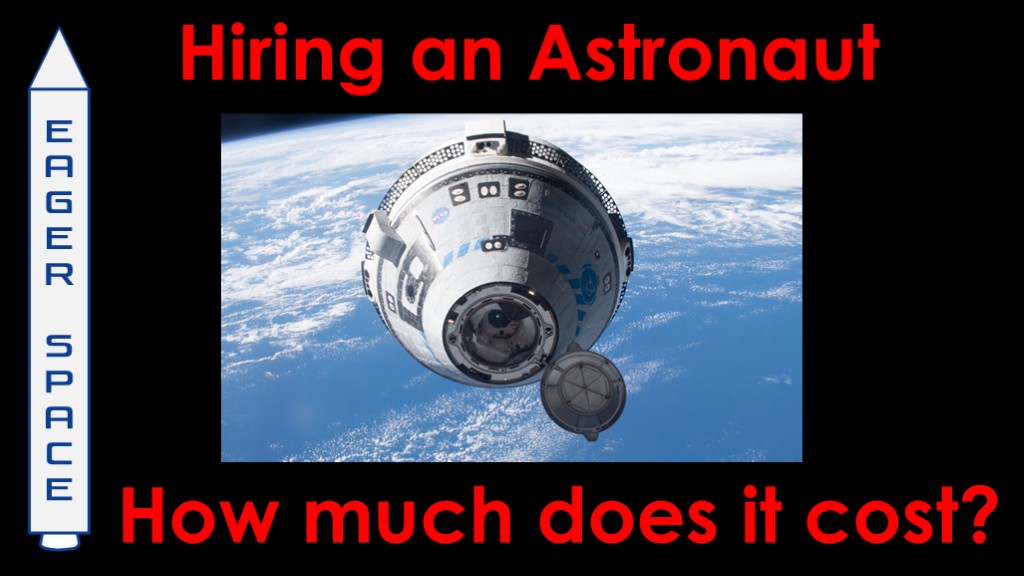
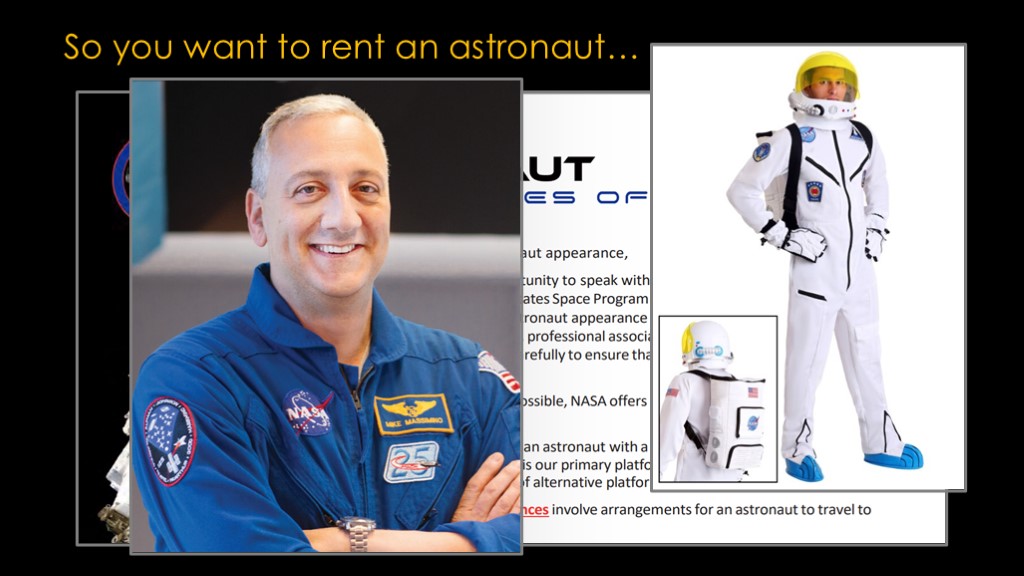
So you want to rent an astronaut.
How much will it cost?
I'd like to make clear that I'm not talking about getting an astronaut to do something on earth. If you want that, you need to go through NASA's astronaut appearances office. There are not surprisingly quite a few conditions and you aren't going to get an official astronaut visit for Suzie's birthday party, no matter how much she loves space.
You could book a former astronaut as a speaker, which will cost you somewhere between $10,000 and $100,000.
Or you could go with a backup plan
https://www.nasa.gov/wp-content/uploads/2015/02/astronaut_appearance_guidelines_2020_updates.pdf
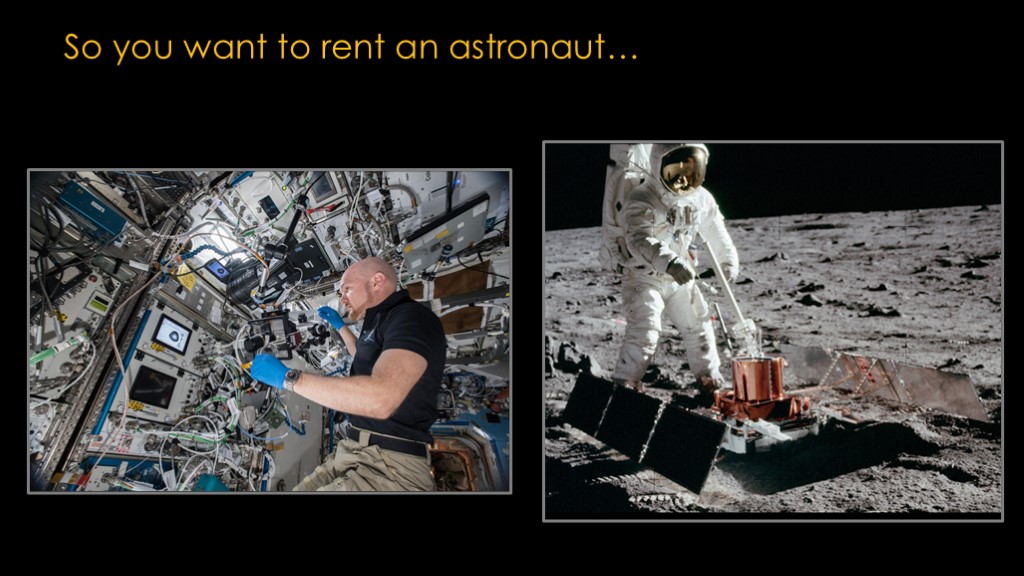
What I'm talking about is wanting to hire an astronaut to do something in space. Maybe you have an experiment on the international space station that needs some human attention. Or maybe you want to do some research on the surface of the moon.

For the international space station, the question is easy to answer - you can get astronauts to work on your experiment for $130,000 per hour. That is the price for astronaut time, but it's not the cost - it's well-known that NASA subsidizes research on ISS.
What is the real cost for an hour of time by an astronaut in low-earth orbit? That's our first question.

Here's the NASA price on a graph...
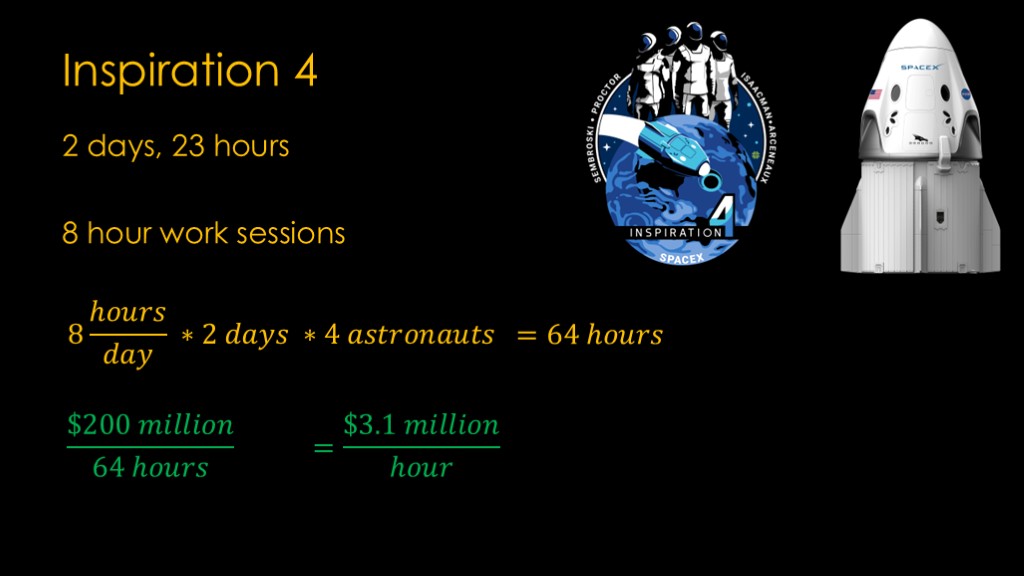
We'll start with the Inspiration 4 flight that was conducted in 2021 on Crew Dragon.
This flight was 2 days and 23 hours, but some of that was getting up into orbit and getting ready to return, so we'll drop down to 2 days.
Now we have to define how much of their time was useful time. There's no standard way to do that for this flight, so I'm going to arbitrarily say that they worked 8 hours of time per day.
8 hours per day for each of 2 days for four astronauts means 64 hours of useful time during the mission.
Jared Isaacman has said that the cost was less than $200 million, so I'm going to use that as an upper bound, and a bit of math gives us a cost of $3.1 million per hour.
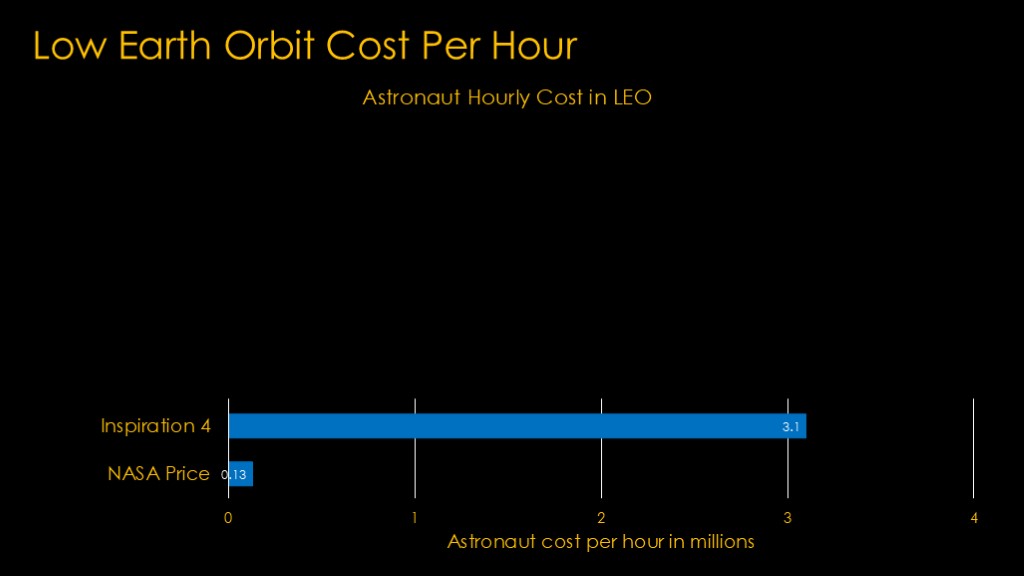
Adding in the Inspiration 4 data, it is about 24 times more costly per hour than what NASA charges.
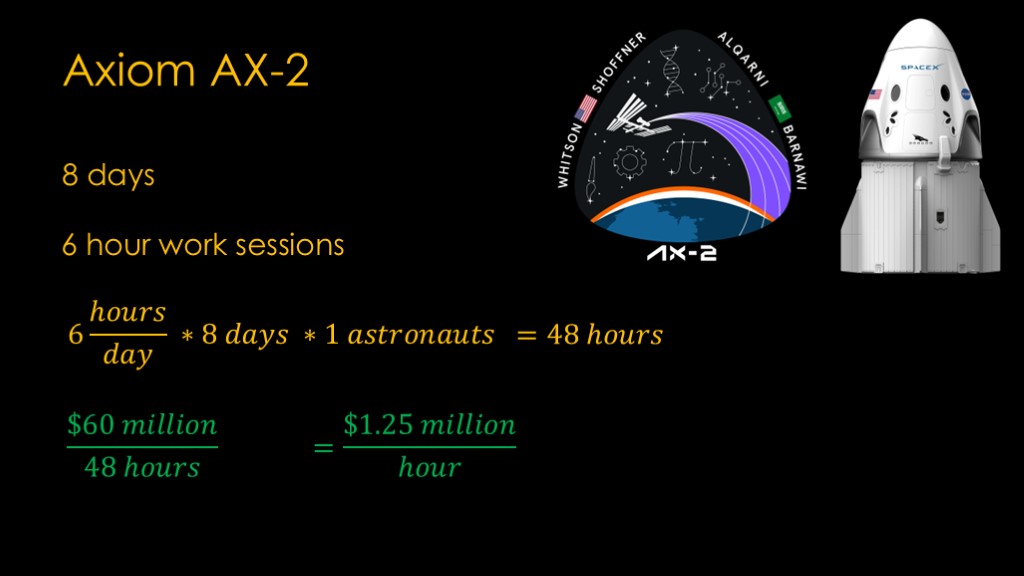
Next up is the Axiom AX-2 mission to the space station.
On this mission, the participants spend 8 days on ISS.
I'll assume they only spend 6 hours doing useful work each day.
That gives each participant 48 hours of useful work time.
We don't know the actual price or cost for that participant, but I'm going to put it at $60 million, which is in the right ballpark.
Math says that's $1.25 million dollars per hour.
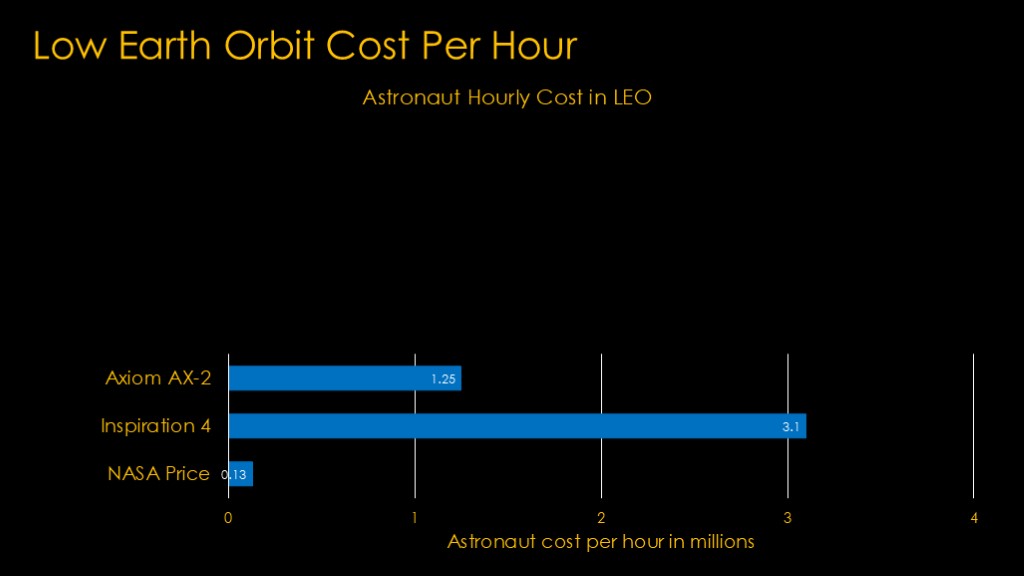
Axiom is quite a bit cheaper - it has similar launch costs, but it has an 8-day mission so there is more time.
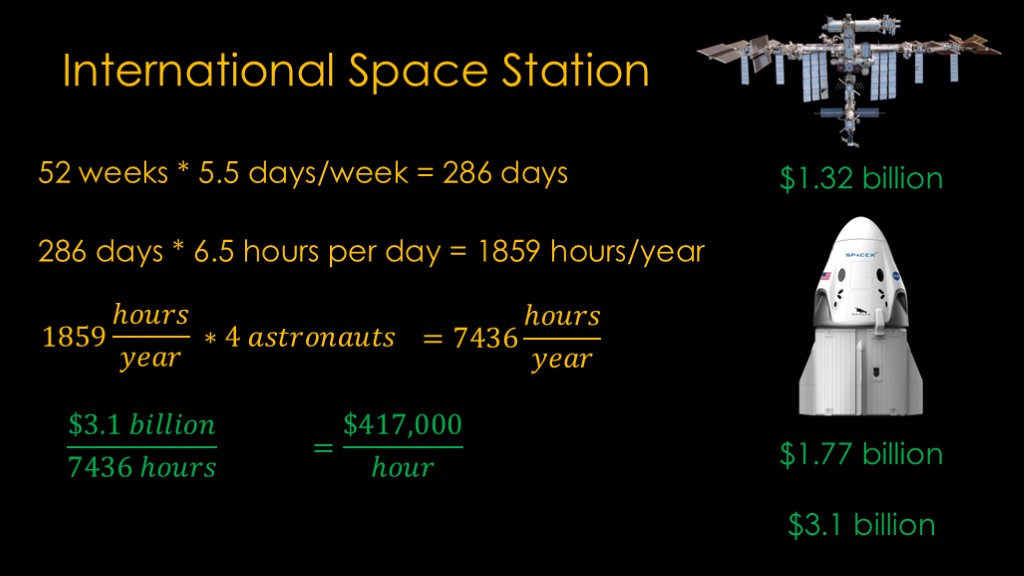
On the space station, we have the advantage that astronauts are there for a long term, so their per hour cost should be cheaper. I thought about doing this on a per-expedition cost, but it's really complicated so I'm going to use a shortcut and look at a year on the station.
NASA astronauts work 5.5 days per week, which means 286 days per year.
They work 6.5 hours per day, for a total of 1859 hours/year per astronaut.
Multiply that by 4 astronauts, and that's 7436 hours/year.
For 2022, NASA requested $1.32 billion to operate the space station and a further $1.77 billion for cargo and crew services, for a total of $3.1 billion.
Take 3.1 billion and divide it by 7436 hours, and we get $417,000 per hour.
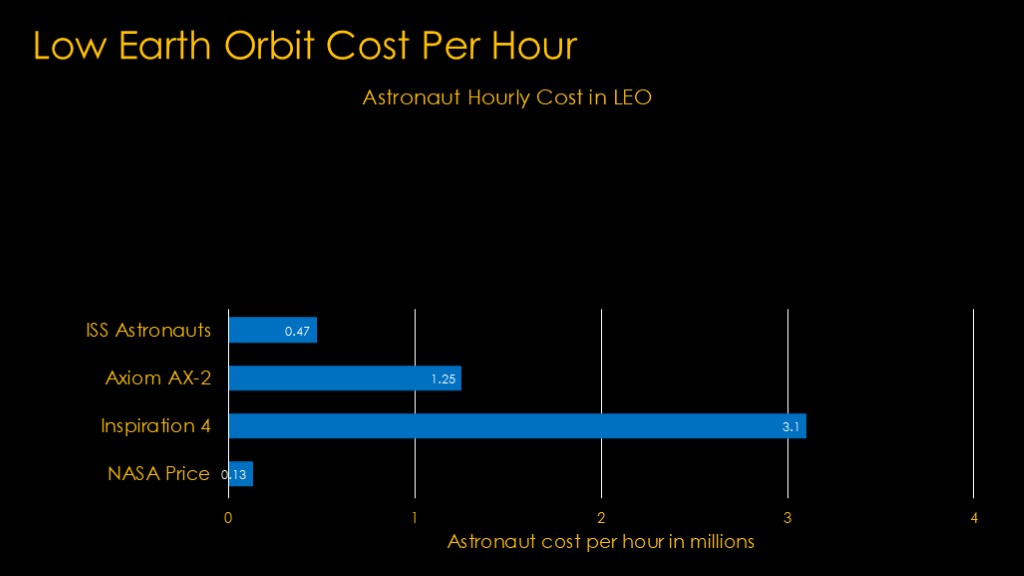
ISS astronauts have long missions, so their cost per hour is fairly low - about 3.6 times the NASA price.
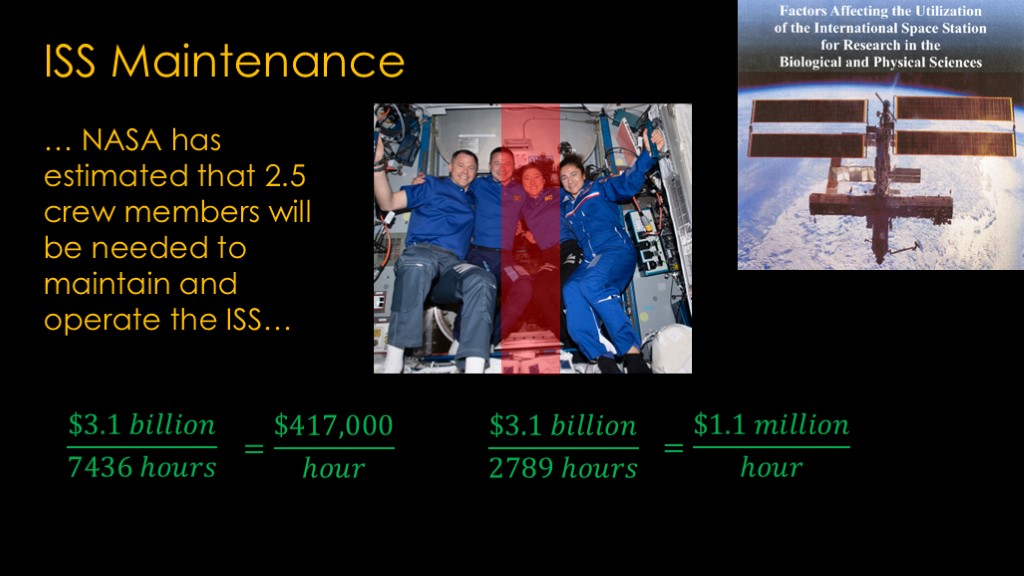
But it's more complicated than that.
Back in 2003 a National Academies report noted that NASA estimates that it takes 2.5 astronauts to keep the space station operational, which means that with the current crew of 4 astronauts, only 1.5 is available to do research.
That means we need to redo the calculations using 2789 hours, and we find that the per hour cost goes up to $1.1 million.
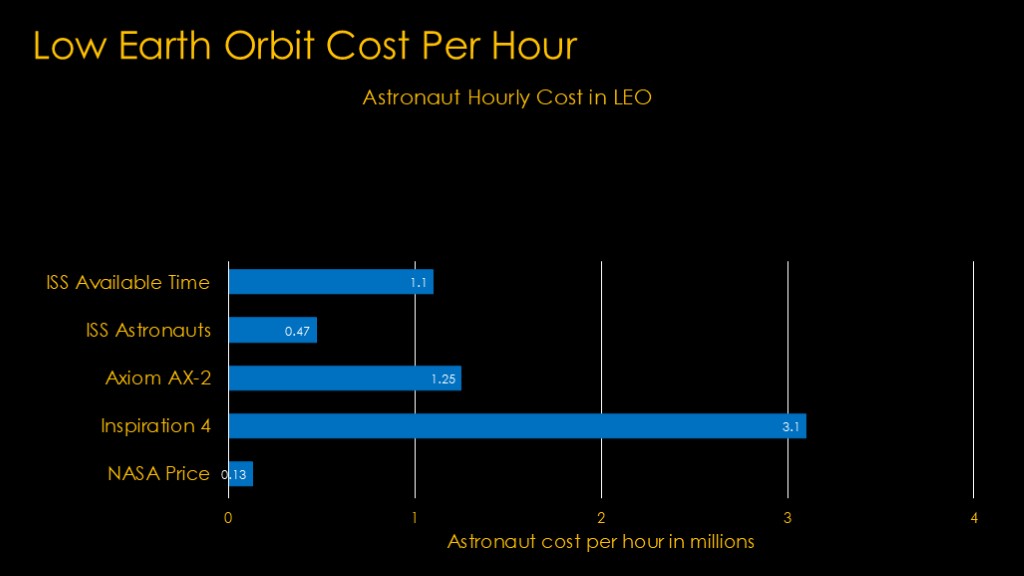
Add in the overhead of running the ISS, and the numbers look quite a bit worse - 8.5 times the amount that NASA is charging.
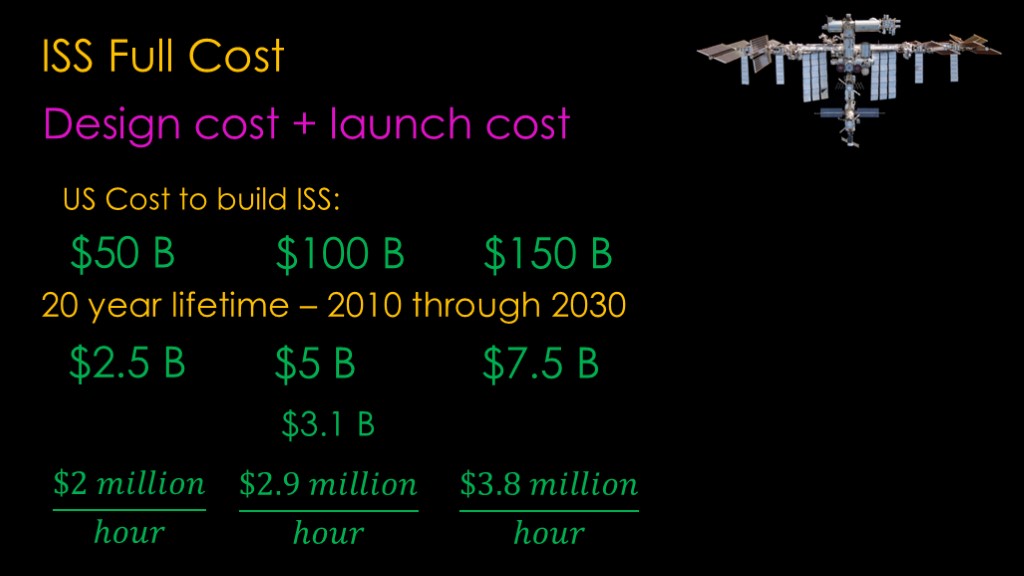
To come up with a "full cost" number, we would want to include the cost to construct the ISS.
We can simply add up the design cost and the launch cost to get that number. For the design cost, there was an ongoing fight about what ISS construction costs were while it was being built and nobody could agree on the cost to design and build the ISS modules. The cost to launch depends on what you think a shuttle flight costs and there is no agreed-upon number there.
When faced with this situation, I typically do a low/mid/high approach. I think that ISS cost the US more than $50 billion to build and less than $150 billion, so those are the low and high and $100 billion is conveniently in the middle.
We can allocate that across the 20 year lifetime to get 2.5, 5, and 7.5 billion dollars a year of construction cost.
Add in the yearly $3.1 billion cost, do some math, and our answers are $2 million, $2.9 million, and $3.8 million per hour of useful time.
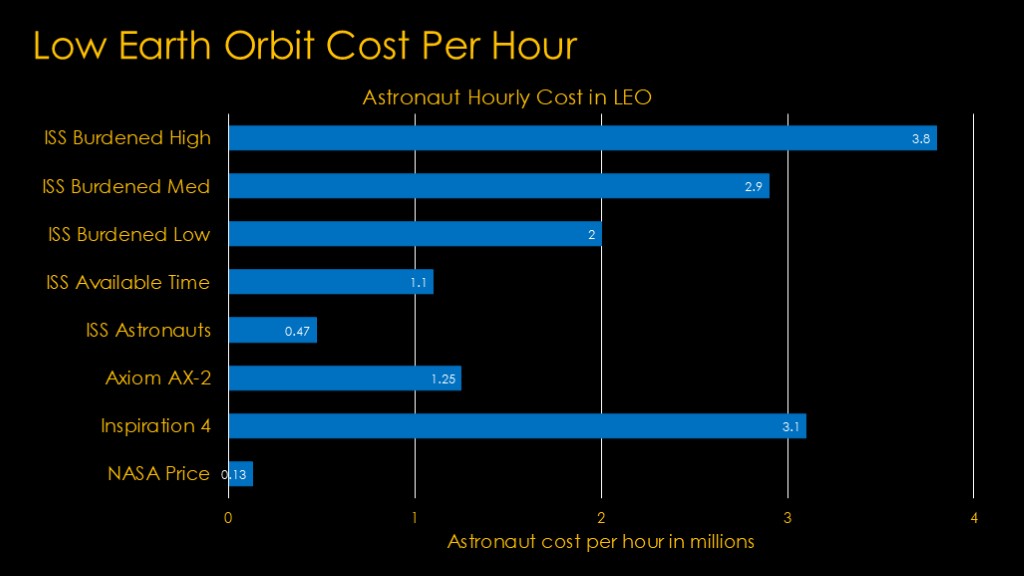
When we add in the ISS construction costs, the cost per hour ends up being roughly what Inspiration 4 cost.
ISS is really cool but wow it's expensive.
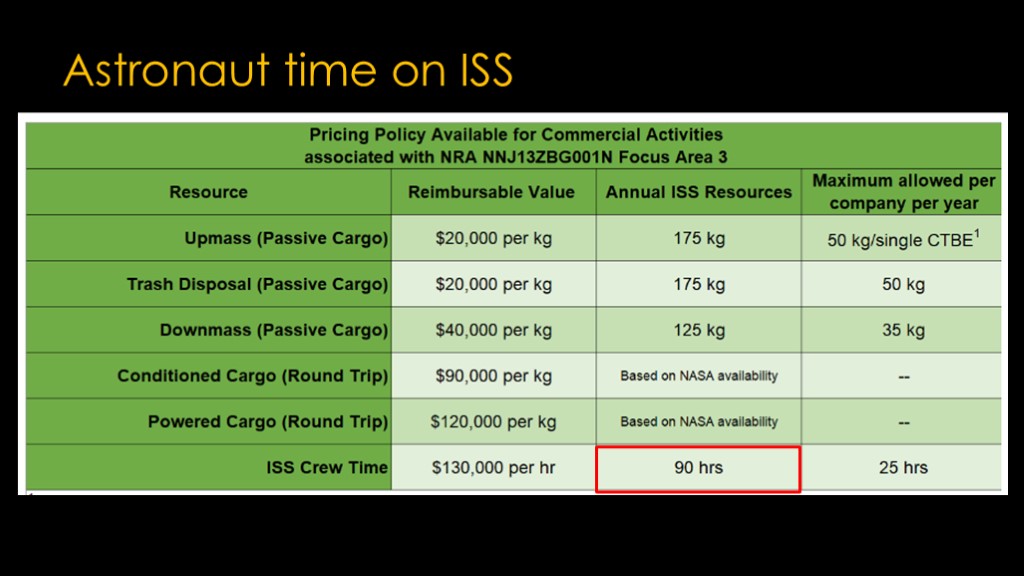
One interesting number from this price chart is that NASA only allocates 90 hours of astronaut time a year for commercial activities, only about 3% of the total amount of astronaut time.
That's not a lot of time devoted to commercial research.
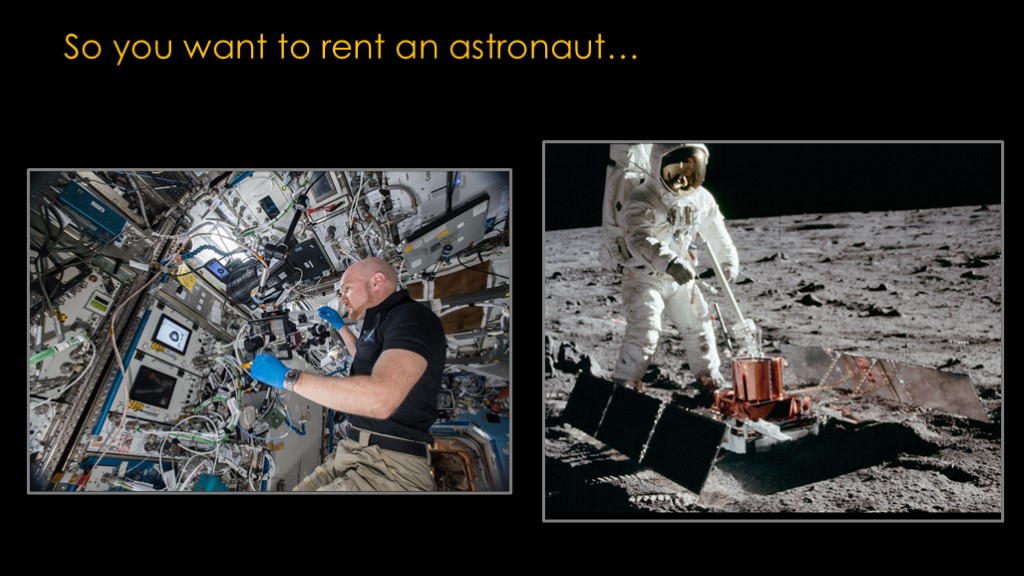
Since we've looked at LEO we definitely want to estimate how much lunar surface time costs.
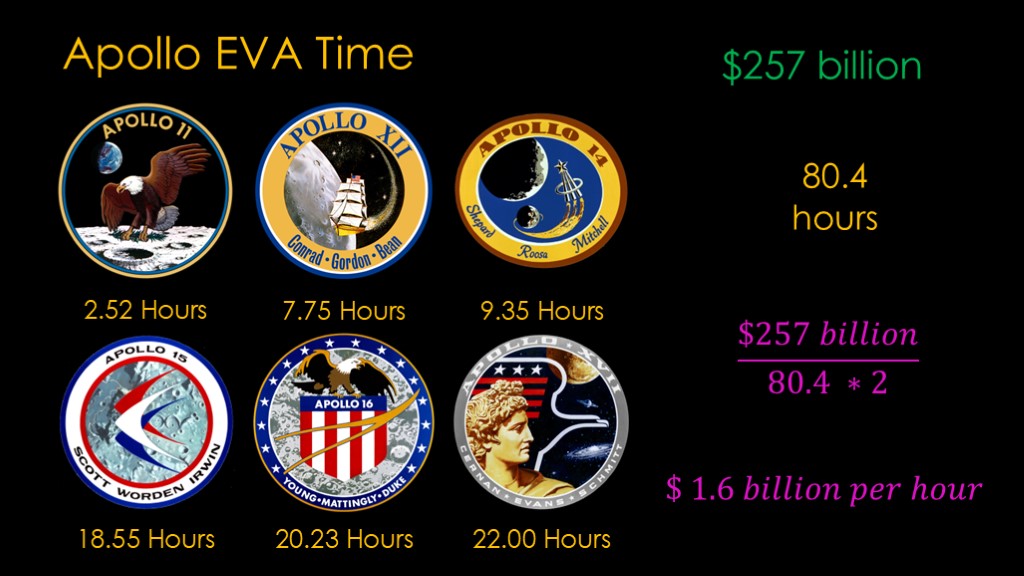
We'll start with Apollo.
Apollo cost $257 billion in 2020 dollars. If we add up the EVA time for each of the missions, we end up with 80.4 hours total.
Do the math - $257 billion divided by 80.4 hours * two astronauts and we get $1.6 billion per hour of EVA time.
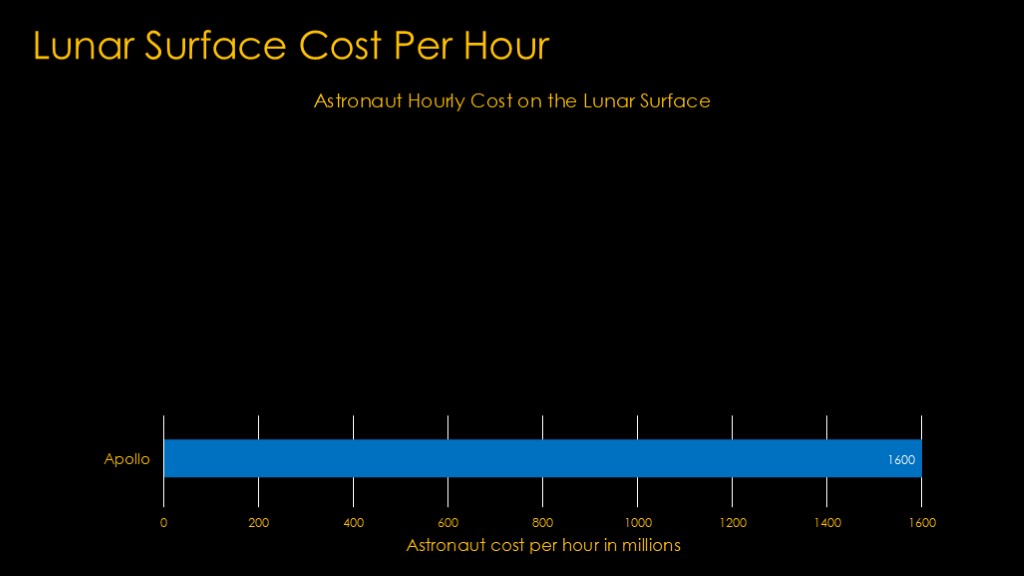
We'll start our lunar chart with that amount.

But perhaps that is unfair.
NASA ran all of Mercury and Gemini and built a lot of costly infrastructure for Apollo. If we look at Apollo 17 and only consider the incremental cost of that flight, we get cost of $450 million in 1972, or about $2.8 billion in 2020 dollars.
With 22 hours of EVA, that brings us down to $63 million per hour of EVA.
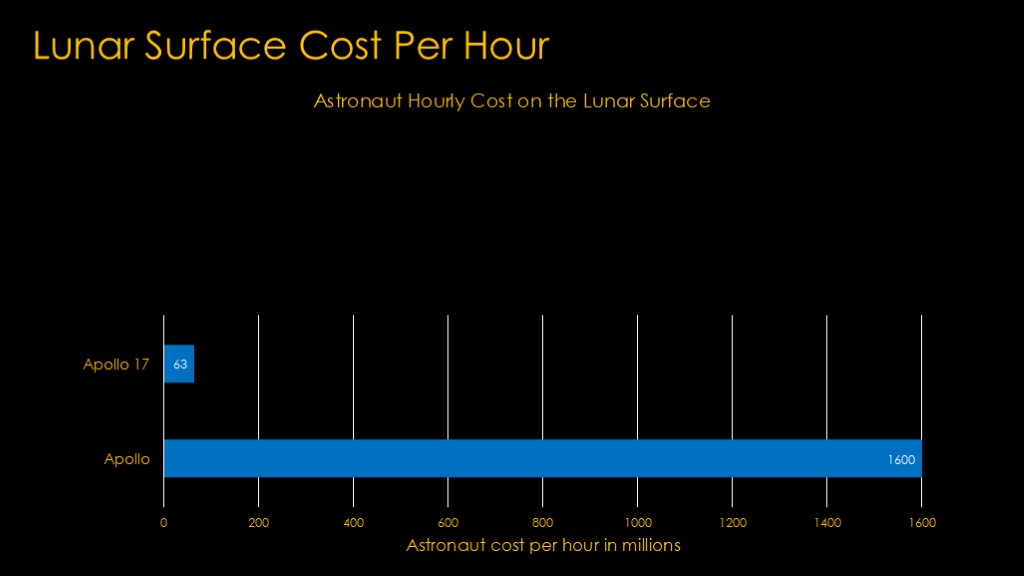
This is obviously far less than the whole cost.
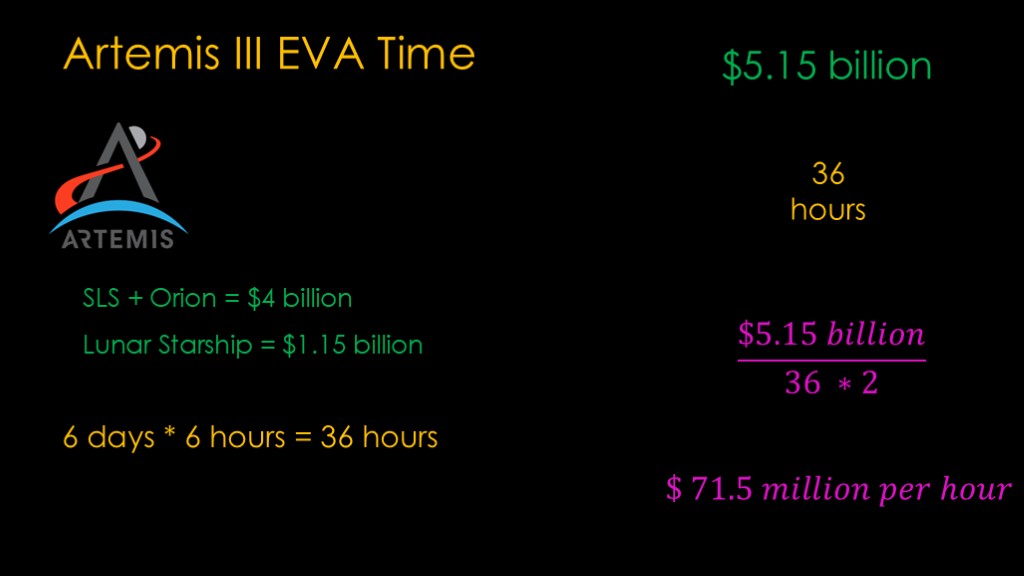
How pricey will Artemis III be?
There are a lot of unknowns but we can still come up with some numbers.
SLS and Orion can fly about once a year and their overall budget is about $4 billion, so we'll use that as their cost. We also need a Starship lander, and for that I'm going to use the price of the second Starship lander, $1.15 billion. That gives us $5.15 billion in total costs.
We known Artemis III will spend approximately 7 days on the surface because that will be the first launch opportunity to dock with Orion to head home.
Assuming 6 hours per day of EVA for 6 of those days gives us 36 hours.
Do the math, and that gives us $5.15 billion / (36 * 2) = $71.5 million per hour
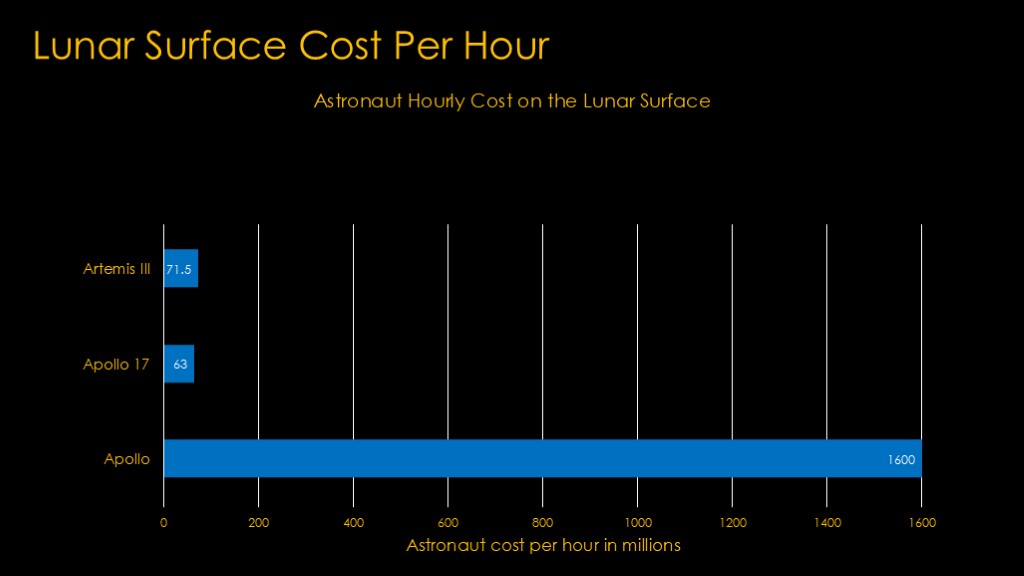
Interestingly, pretty close to Apollo 17.
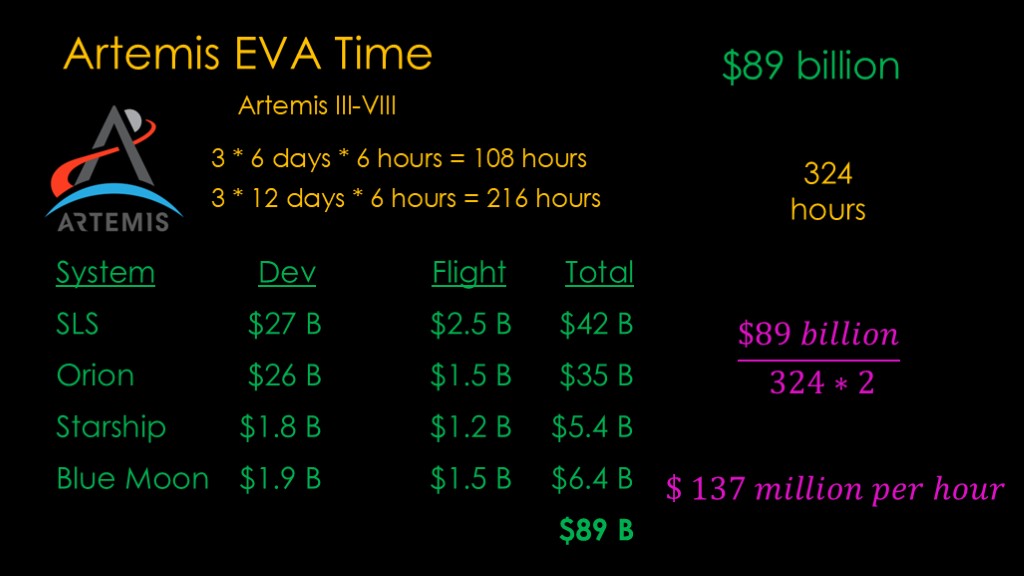
This of course ignores the development costs for Artemis.
I'm going to arbitrarily assume that there are 6 lunar missions and half are one week and half are two weeks. That gives us 3 missions at 36 hours EVA time for 108 hours and 3 missions at 72 hours for 216 hours, or 324 hours total for all 6 missions.
Costs are complicated...
SLS cost about $27 billion to develop in 2022 dollars, and it spends $2.5 billion a year for 1 flight, so $15 billion in flight costs and $42 billion total.
Orion cost $26 billion to develop and $1.5 billion per flight, so 6 flights gives us $35 billion total
Starship costs $1.8 billion to develop and $1.2 billion per flight for 3 flights, so $5.4 billion total
Blue moon costs $1.9 billion to develop and $1.5 billion per flight, so 6.4 billion total.
Add that all up, and we get $89 billion. We're missing some costs - the cost of the spacesuits from Axiom, the cost of the CLPS exploratory flights, and any costs for gateway.
We take that 89 billion and divide it by 324 hours for each of the 2 astronauts, and we get $137 million per hour.
There might be more astronauts on some missions which would reduce the price.
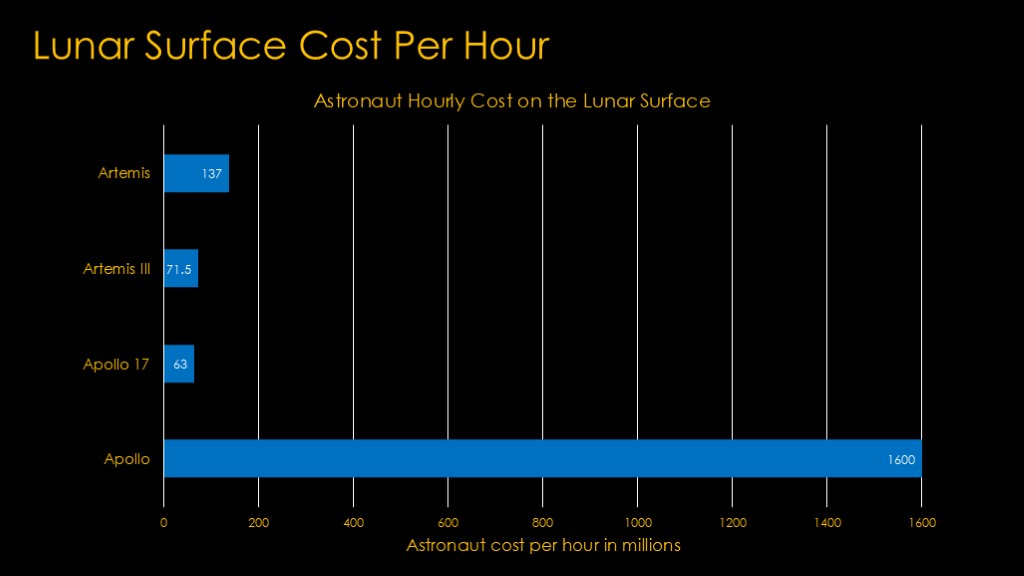
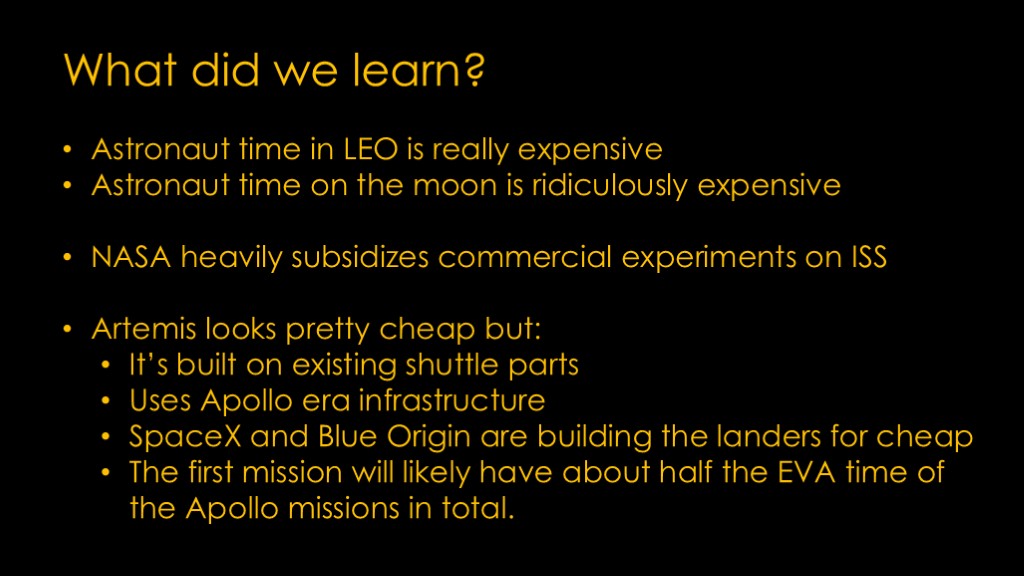
What did we learn?
First, astronaut time in LEO is really expensive, and astronaut time on the moon is ridiculously expensive.
Second, NASA heavily subsidizes commercial experiments on ISS, at least when it comes to astronaut time. That means that applying NASA numbers towards commercial space stations probably doesn't work very well. But that's a topic for another video.
Third, Artemis looks cheap, but it's built on existing shuttle parts, uses apollo era infrastructure, the landers are provided to NASA at a huge discount, and the on-moon mission times are going to be a lot longer than the Apollo ones.
Finally, Suzy is going to be disappointed at her birthday party.
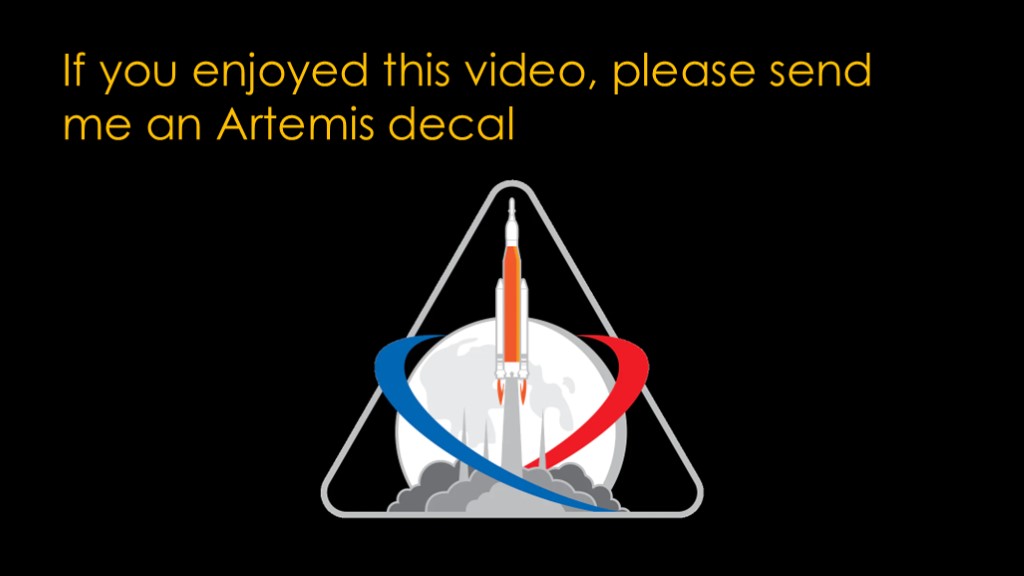
If you enjoyed this video, please send me an Artemis decal for a buck ninety five.